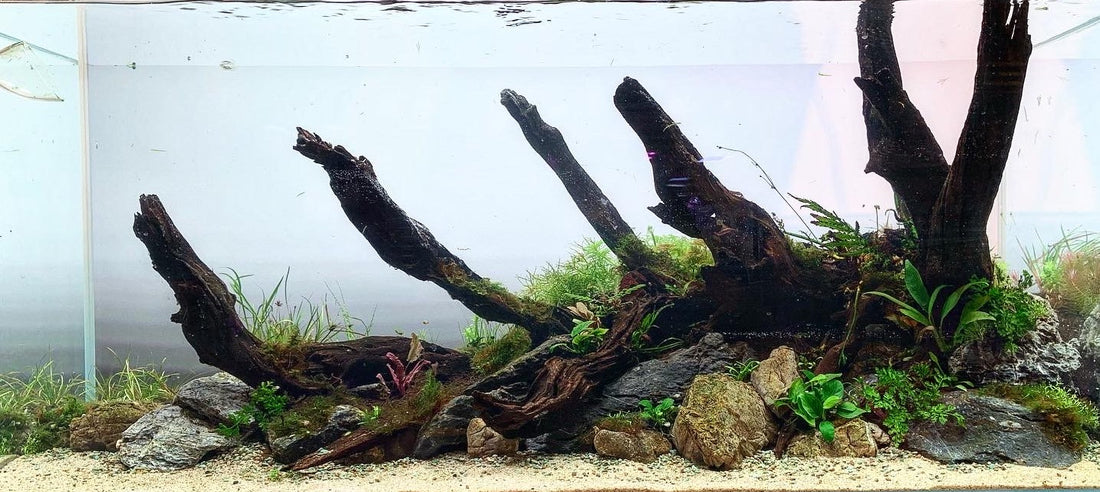
When to add liquid fertilisers for planted tanks?
Share
As one of the most common questions asked, we are here to discuss on when it is best to begin adding liquid fertilisers to your planted aquarium tanks.

First of all, we need to think about the substrate that we use. If the aquarium is newly set up with a nutrient rich soil substrate, this substrate actively influences the water parameters and the nutrient ratio of water. They give off large amounts of nitrogenous compounds however they do not leech all required nutrients at a sufficient rate and due to their cation-exchanging properties, they absorb minerals like calcium, magnesium and potassium.
Start fertilising on Day 1
Plants require a full set of nutrients to grow optimally. For this reason, macronutrients should be added from Day 1 to close possible nutrient gaps so that plants can get through the adaptation phase more effectively. If this does not happen and there are no nutrients in the substrate, fresh plants may begin to melt. Easing the adaptation phase is important therefore supplying plenty of CO2 and adequate amounts of nutrients is an important step in preventing melting and accelerating adaptation in the new environment.
Additionally, new plants do not have established root system, which limits their ability to draw nutrients from the soil. Aquatic plants are able draw nutrients from their leaves as well, therefore having nutrients in the water column gives them easy access to nutrients before their root systems are fully developed.
How much do i add?
During the start of your planted tank, the plant mass is still quite small and the plants need to adapt to their new surrounding. For micronutrients, they do not need a large amount and can be added using NEO Solution 2 or NEO Solution Fe. It is recommended to use a reduced fertiliser regimen often one third to half of the recommended dose specified by the manufacturer. As soon as the plants have adapted, you can see any iron deficiencies in the shoot tips described as the leaves turn pale to white. Most stem plants react quite fast and this sets an indicator to increase the amount of the fertiliser bit by bit until these symptoms go away. If you notice red algae such as black staghorn algae or beard algae, the amount of fertiliser is too much for the time being.

For macronutrients such as potassium is often not adequate in tap water. It is recommended to add fertilisers containing potassium such as NEO Solution 1 or for more precise control of the individual nutrient we can use NEO Solution K. Depending on the type of fertiliser, for example NEO Solution 1 it is advisable to dose half the recommended dose specified by the manufacturer and increased as plant mass grows. For individual nutrient dosing of just potassium, a full dose of the recommended dose can be added.
Timeline examples
In the following, we will show the fertilising schedule using Neo Solution range during the cycling phase, keeping in mind that this is just an example and conditions of your tank may vary. A good tip is to look out for your plant growth and presence of algae over time as these are great indicators for deficiency in nutrients or excess of nutrients.
Day 1
Setup and planting with installation of all equipments. If you have bacteria starter in hand, apply them as per manufacturer's recommendation to speed up the cycling process. Start adding reduced amount of macronutrients (NPK)
Day 3
Change at least 50% of water and add reduced amount of macronutrients (NPK) and reduced amount of micronutrient
Day 6
Change at least 50% of water and add reduced amount of macronutrient and micronutrient
Day 8
Test the water, especially for ammonium (NH4) and nitrite (NO2), change at least 50% water
After week 1
Change at least 50% of water on Day 11 and continue reduced amount of fertlisers
Day 15

You will notice brown algae (diatoms) by now. Check your water parameters and if within range (ammonium peak over), you can put in your invertebrates algae eaters (snails/ amano shrimps)
Day 18
Change at least 50% water
After week 3
The plants should have adapted and assumed their submerged form. Roots systems would have grown visibly and developed. It may even be time to cut back fast growing stem plants. The plants may begin to show signs of deficiency. Optimise your fertiliser regimen based on the condition of the plants. Green algae layers or green hair algae are normal during this phase and you will notice the decline in diatoms
Day 23
Start your optimised fertiliser regimen of macro and micronutrients
Day 25 and 28
Change at least 50% water
After week 4
This is most likely the turning point of your tank as the nitrogen peak has come to its end and the basic supply of macronutrients especially nitrogen in the form of liquid fertiliser should have come into balance. Water change can now be done once a week and check your water parameters before adding fishes in. The plants will slowly grow and win over the algae as it competes for nutrients. If there is still algae, remove them manually, add more algae eaters or do more water changes keeping to your optimised fertilising regimen.
The cycling phase may have completed however the biological system inside the aquarium may not be fully stable until another one or two months. Keep a look at your plant growth, livestock behaviours and appearance of algae and water parameters to react to possible problems before they establish.
